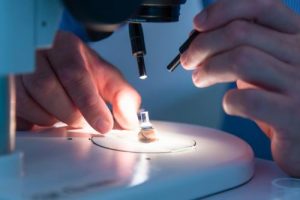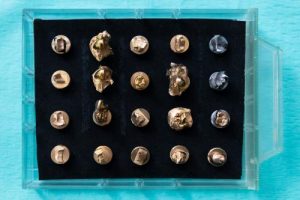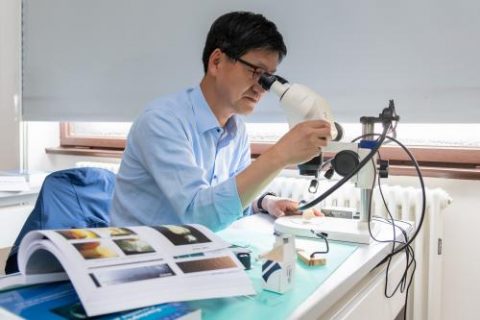Working on fractures – International Fracto Course 2019 held in Erlangen
Unique course in Erlangen brings dentists and engineers from all over the world together at the microscope
It’s a lovely summer’s day, you’re sitting on a deckchair enjoying a piece of delicious plum cake, when suddenly you hear a crunching noise and feel a searing pain in your mouth. You realise you’ve bitten on a plum stone and one of your crowns has come loose. ‘It’s not only painful when this happens, but also quite annoying,’ says Prof. Dr Ulrich Lohbauer, who is a researcher at the Department of Operative Dentistry and Periodontology at Universitätsklinikum Erlangen. ‘Not only does the patient urgently need a dentist’s appointment, but they often also have to pay to have the crown repaired.’ Ulrich Lohbauer’s aim is to prevent this from happening to as many people as possible. As an engineer in materials science, he takes a closer look at such fragments to find out whether the materials used are to blame. Was it the adhesive or how the tooth was prepared? Every two years, Prof Lohbauer and his team pass on their many years of expertise and extensive knowledge to colleagues from all over the world in a unique training course. Participants travel from as far afield as Asia, America and even New Zealand to take part in the course run by the team in Erlangen.

‘I was familiar with the names of the specialists at Universitätsklinikum Erlangen from reading several specialist journals, which is why I registered to take part,’ says Hae-Hyoung Lee, who is an engineer from South Korea and one of this year’s course participants. ‘I especially like the fact that I can exchange ideas with people from around the world and from other disciplines.’ There are 20 spaces available on the course, which were booked by dentists, engineers, and researchers from universities and also industry. ‘This is most definitely a hands-on course that combines theory and practice,’ says Prof. Lohbauer. ‘On the first day we investigate experimental approaches from the laboratory, the second involves current clinical practice and on the third, we take a look at the future of our work and research.’ In addition to Ulrich Lohbauer, the course is organised by Dr. Renan Belli, who is also a researcher in the Department of Operative Dentistry and Periodontology at Universitätsklinikum Erlangen, Prof. Dr. Susanne Scherrer from the University of Geneva in Switzerland and Prof. Dr. Paulo Cesar from the University of São Paulo in Brazil.
Looking for clues

Crowns, bridges and implants are manufactured from a variety of materials, for example ceramics. The researchers conduct systematic research into the causes of fractures or cracks in these materials. ‘Like detectives, we search for clues on the fracture surfaces to find out how and why this dental prosthesis has broken,’ says Prof. Scherrer when describing her role and shows us a number of small boxes that contain several gold-plated models of real damaged dental prostheses. ‘Using these very different samples, participants on the course learn to identify fracture types, surface structures and so on under the microscope.’ Participants from all professions can later use this knowledge in practice. ‘Fractography, which you could call the science of fractures, forms the link between development in the laboratory and clinical application,’ explains Prof. Lohbauer. Or to put it more simply: On this course, engineers get to experience which stresses the materials they develop can withstand in the human mouth and which they do not. Dental technicians learn what they need to keep in mind when creating dental prostheses and dentists learn how to ensure the adhesive used is as durable as possible. In addition, participants get the chance to look beyond the boundaries of their profession, learn from each other and increase their understanding of the requirements placed on durable dental prostheses.
Erlangen is an ideal location for research
‘All participants make a conscious decision to take part in this course,’ says Ulrich Lohbauer. ‘Unfortunately, fractography is yet to be included in the training of dental technicians or in dentistry degrees. We would like to see this change, as this knowledge benefits patients directly.’ This is precisely the reason why, as an engineer, Lohbauer decided to pursue a career at Universitätsklinikum Erlangen. ‘Materials science is a very broad field, but here at the Department of Operative Dentistry I get the chance to work closely with people. My research findings are transferred comparatively quickly into patient care.’ According to Prof. Lohbauer, the unique location of the hospital next door to a university which offers the entire spectrum of academic disciplines such as FAU is also a factor that speaks for Erlangen. This means both students and researchers do not have to travel very far. For example, dentistry students from the Faculty of Medicine can visit the researchers at the Faculty of Engineering if they need more information about the development of new biomaterials. ‘Our hands-on course also benefits from this proximity and the expertise available,’ says Ulrich Lohbauer. ‘We can use the extremely well-equipped facilities of the Institute of Pathology and the state-of-the art stereo microscopes of the Palaeontology Department – today there are teeth instead of fossils under the lens.’
Further information:
Prof. Dr. Ulrich Lohbauer
Phone: +49 9131 85 43740
ulrich.lohbauer@fau.de
